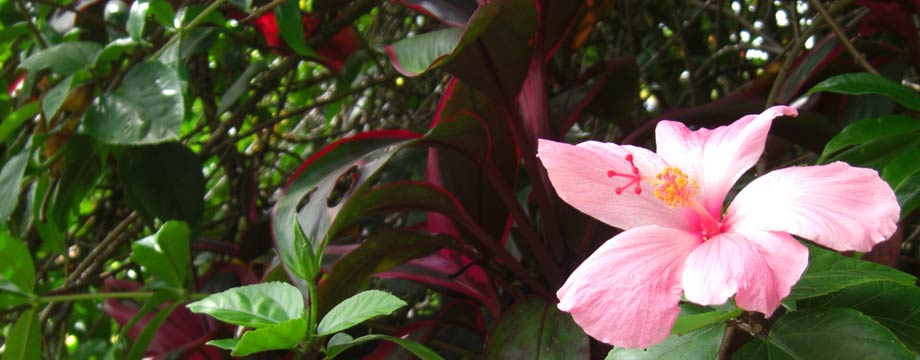In the past four days, I have already seen 3 snakes. One I spotted on the road, smashed (most likely when it was sunning itself) and attracting flies. I saw two yesterday in Saga-ken. The first one I saw when I was visiting Kannon no taki (Kannon waterfall) in Nanayama-mura (Seven mountain village). I jumped over a rock, and it quickly slithered away under some dead branches. Not feeling quite Irwin enough, I decided not to reach in the tangled foliage and to let it be. Instead, I checked out the awesome waterfalls. If you are passing through Saga-ken, this place is worth a visit.
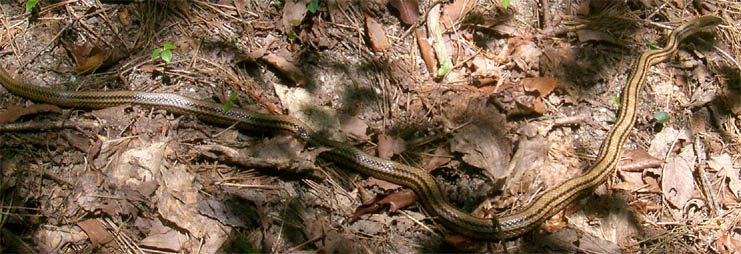
Anyhow, Kuniko spotted this snake (at Kashibaru Shikken, or Saga Marshlands, North of the Nagasaki Expressway on a small road that shortcuts the 323 toward Nanayama. if you can make it here around August, you should be able to see a beautiful flower called the Sagisou that looks like a bird in flight. this is a prime wetland habitat, a rare find in Japan and the biodiversity is much more apparent and colorful than the vernal pools of Santa Barbara), that remained absolutely still, well camoflauged among the dried foliage. I was able to get really close to it, and finally learned how to use the macros function on my digicam (thanks for the prodding, Justin):

Kuniko thought it was dead, and so I was obligated to show her otherwise. I grabbed its tail, and it whipped its body two feet away from me in a split second. After I grabbed it again, it started rattling the dried leaves with the tip of its tail in the manner of a rattle snake, and then bolted into a well concealed rathole. I don’t think this snake was poisonous, but can’t say for sure since I was not bitten.

According to the Japanese snake guide, this appears to be a Japanese four-lined snake, or Shima-hebi. I don’t know why I have this compulsion to play with the snakes that I encounter. All that I can say is that it’s fun (until I get bitten/envenomated I suppose).
Snake Season
My Dog, Shisar
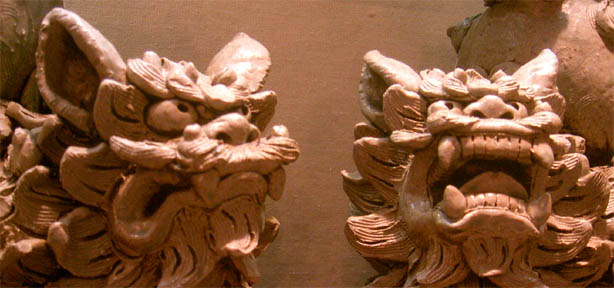
These dogs are Shisar, the guardians of the Ryukyu (Okinawan) Islands. You see them all over the place in Okinawa, on keychains, t-shirts, and anything else that is sold on the Kokusai-dori (the main tourist street in Naha).
Of all of the Shisar statues that I encountered, I especially like these. They remind me of our Pekingnese dogs, especially Jane. That was one cool dog.
I just watched Kill Bill vol. 1 two days ago for the first time, and spotted Shisar in two different scenes. When Black Mamba is purchasing tickets for Okinawa (one way) a pair resides on the back shelf, over the shoulder of the booking agent. The more obvious scene, of course, is when Hattori Hanzo’s steel is unsheathed for the first time. That’s Shisar, imprinted on that legendary blade.
On that note, I am looking forward to part 2. I think I may have to brave first night crowds tomorrow, because I don’t want to wait to see it!
Okinawan Sign Language
I usually find signs that I like when I travel to foreign places, especially if the populace has a less than perfect command of English. I’m sure that the locals were wondering why I was taking picures of the mundane icons that are filtered out of their focus. My choice of subjects to photograph most likely flagged me as a tourist, to the locals who were trying to get me to purchase their assorted omiyage. Okinawans are a true breed of hustlers, and it was painful watching my companions getting fleeced. But that’s the topic of a separtate post.

This picture is of a dental clinic in Okinawa. A couple of thoughts popped into my mind when I first saw this, such as:
“No way!”, “Ouch!”, “Has to be two different sets of teeth!”, “I wonder if the same set of pictures accompanied by English appears in England?”, and “That dentist must be a friggin’ god/butcher!”.
I have seen some pretty bad teeth in Japan, but many people are now wearing braces and taking better care of their teeth than before. This picture makes me cringe when I think of the pain that the patient had to endure. How many cc’s of lidocaine was injected into that gaping maw?
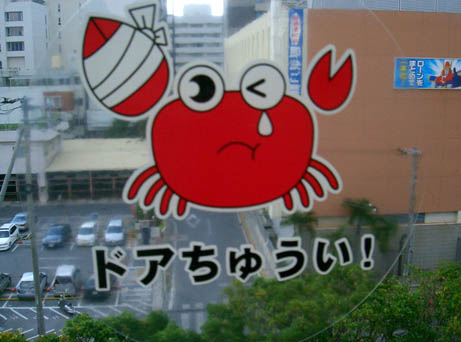
This next picture is the Japanese equivalent of the French Metro Bunny. On a side note, I feel responsible for contributing to the widescale spread of American tourists stealing those stickers. In 97, after returning home and showing a friend the mementos of my trip, he thought it was such a cool sticker that he did it, and everyone else who went to study abroad with Orange Coast College that year followed suit. It became a tradition, and soon there was a shortage of stickers on the metro (and a sharp increase of people getting their hands caught in the doors, I like to imagine). So this time, instead of stealing a physical copy, I captured one on my camera.
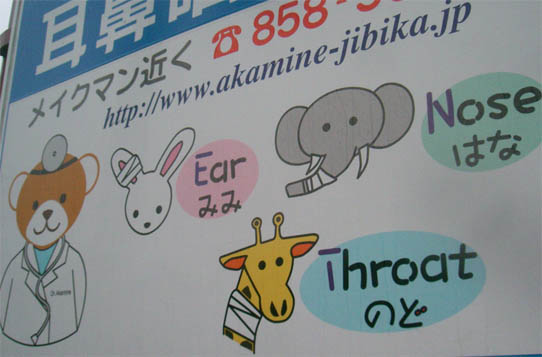
If I had a problem with my ears, nose, or throat, this is the doctor I would want to go to. For some reason, these images evoke a feeling of trust for this doctor, even though I have never met him.

This last sign was taken in the domestic terminal of the Okinawa Airport. I understand the need for explicit directions, but this goes a bit further than necessary. I mean, did someone try to argue “but officer, I didn’t know that it was wrong to stash my guns and drugs on top of my bag filled with decomposing decapitated heads that I was using to feed my pet weasels. Oh and don’t worry, the pipe bombs aren’t really dangerous because I didn’t insert the fuses yet. You know, someone should really put up a sign to make it clear just what exactly IS acceptable to keep in these lockers! They didn’t seem to mind up in Kansai.”?
AFK
I will be gone until Tuesday to Okinawa, another trip with the Ubuyama Fire Brigade (only 12,000 yen!!!). Therefore I will be out of reach of computers and technology, and will be drinking like a fish and diving instead. If you need to contact me call me on my cel.
Adam
Update
I finally got back this morning in time for work, after four full days of travel and adventure. It went something like this: on Saturday I got my larynx bruised in Jiu-Jitsu fighting Luke and then I taught some English in the city and rushed back to do essential laundry (read: I was completely out of clean underwear). The next day, I left with the firemen, and started drinking from 10 in the morning and spent the rest of the night in Okinawa buying omiyage and drinking some more at a snack bar. On Sunday, we took a boat out to a beautiful set of small islands and took 1 dive and multiple snorkeling excursions. This, of course, was followed by more snack bars and much more drinking. Yesterday we visited the castle in Okinawa and a war museum. Right before our return flight boarded, Joe gave me a call and asked if I wanted to meet him in Fukuoka to see the String Cheese Incident. So I decided to ignore my second day hangover, and we had a blast. Today I am tired from playing too hard, and the weekend is almost upon us again. I must have done something right in my past life or something, because lately everything seems too good to be true.
Heavy Books
About 7 years ago, my brother sent me a copy of Snow Crash, and ever since then I have been a huge fan of Neal Stephenson. In my first year at UCSB I hunted down a copy of The Big U, before it was reprinted and when it was being sold for ridiculous amounts of money at auctions. In the Beginning was the Command Line inspired me to learn more about Linux and even to go as far as installing a separate hard drive dedicated to Linux on my computer for a short time.
I have finished all of his books relatively quickly, except for Cryptonomicon (which took me a month) and Quicksilver. I have been reading this book for the past six months, and I still can’t read more than 10 pages at a stretch. Reading this book is at least as laborious as reading Heart of Darkness by Joseph Conrad (not to be confused with Army of Darkness, by Sam Raimi). I have read my way more than half way through it, but making progress requires the discipline and patience of a highly motivated scholar. Reading this book makes my brain hurt from trying to process and absorb so much information.
And now I just read that Stephenson has already released another book in the Baroque Cycle series (so quickly after the long awaited release of Quicksilver) called The Confusion. I want this book, but Quicksilver has humbled me. Many other books have been devoured effortlessly in the same time period, but it still remains by my bed unfinished.
What really amazes me is the versatility of Stephenson as an author. He (along with Gibson) defined cyberpunk with Snow Crash and The Diamond Age. I enjoyed these books so much that I have read them several times and wouldn’t mind reading them again in the future. The Cobweb and Interface were interesting books that Stephenson and his uncle (J. Fredrick George) penned under the pseudonym Stephen Bury (is the last name a reference to the bury/disinter commands that he writes of in Cryptonomicon?). One deals with bioterrorism and the other with politics and medicine (this one reminded me of a book that was written by Harry Harrison and Bruce Sterling, but I forget what the title was). I also really enjoyed reading Zodiac (check out this page: Yamamoto and the Secret Admirers, heh!), his “Eco-thriller” novel, as a break from reading about the dangers of PCBs and Dioxin in my Environmental Studies coursework.
The cool thing about reading Stephenson’s works is that he likes to write about things that he hasn’t written about before. You can tell that he does his homework and knows what he’s talking about. After reading his books and articles in Wired, you can tell why the man does not want to be bothered by people he doesn’t know- he’s busy working on writing something. Let the man have his privacy! It feels reassuring to know that he is putting down words on paper instead of giving away his time and attention to random people.
I wonder how long it will be until one of his novels is made into a movie. I kind of hope that one never is. No, I don’t think Peter Jackson would be the director to do it justice and NO, Edward Norton would not be a good candidate for Hiro Protagonist. I think that the best adaptation would be an Anime movie directed by either Otomo Katsuhiro (Akira) or Oshii Mamoru (Ghost in the Shell/Kokaku Kidotai).
Just in case you want to read his articles in Wired:
In the Kingdom Of Mao Bell
Spew
Mother Earth Mother Board
Colors Of Spring
I love all of the seasons in Japan. Summer is great because Ubuyama is up in the mountains, and so we escape the oppressive heat that brings gallons of sweat trickling down the faces of those who live in the city. Summer also means going to the beach, and trying to avoid the jellyfish (kujira).
Fall is great because the heat and the humidity gradually decrease into the most comfortable zone of the whole year. The Cosmos flowers come into full bloom at the Higothai Koen and Kuju Hana Koen, and young couples flock to all of the makeout points around Aso. Also, areas that are densely packed with deciduous plants turn amazing colors (my favorite area during this time is Kikuchi Gorge). Towards the end of Fall it starts to get cold, and so the kotatsu table is dusted off and perpetually switched on.
Winter is very cold, but it means that I can go snowboarding again, and practice driving in the snow. During these cold months I cook things that are hot and warm the body from the inside out. This past winter I was able to tweak my nabe to new heigths of deliciousness, with new layers of flavor.
Spring means Hanami, and also means that I can return to wearing shorts and short sleeved shirts. This is my favorite time of year, because life returns to Aso. The insects pupate, hatch, and otherwise appear again, and so I pull out the flyswatter and keep the pesticide ready to put the hurt on any centipede unlucky enough to find its way into my home. The days last longer, and everyone is in a good mood and ready to enjoy the good weather.
The three flowers that mean spring to me in Kyushu would have to be sakura (cherry blossoms), daffodils, and nanohana (rapeseed flower). Unfortunately, I forgot to take pictures of nanohana, so you will just have to take my word for it- they are beautiful. The fields of nanohana are reminiscent of the fields of mustard back home, but the stalks are thicker and more of a luscious green, and the flowers are larger and make the yellow of the mustard look muted in comparison.
I don’t consider myself a “plant person”, and any plant that I have ever cared for in my house has died or come very close to it. However, seeing these vibrant flowers and feeling the change of the seasons has made me develop an interest in flowers. You can’t know what I’m talking about unless you have experienced it, and my descriptions will probably sound overly sentimental. Well, maybe pictures will convey what my clumsy verbage can not.
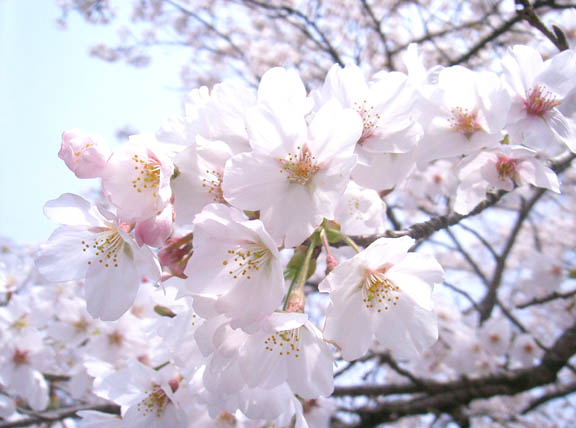
The sakura is percieved by many as a metaphor for the fleeting nature of life (if you have taken any classes on Japanese culture or even watched television programs on the Discovery Channel, specifically ones on Ukiyo-E, then this should sound familiar), but I just like to look at them and to sit underneath the sakura as they flutter down around me. These blossoms last only about 2 weeks, and many times strong winds and rains can expedite the process. If you are planning on coming to Japan, I would recommend coming during Hanami season if possible. Trust me, it’s worth it.

Around the same time that the sakura come into full bloom (mankai), the nanohana and daffodils show off their yellow petals. I like this picture because the daffodils behind the barbed wire is symbolic. I don’t know what exact symbol it is but trust me, there’s some symbolism to be found here.
Tips On Passing The Driving Test (for converting a Foreign License) In Kumamoto-ken, Japan
Driving in Japan is expensive, complicated, and sometimes frusturating. Following someone who is driving under the (already maddeningly slow) speed limit, cars pulling into the middle of fast moving lanes of traffic (almost) causing accidents, constant roadwork and the workers directing traffic with lightsabres, baffling driving etiquitte, traffic cameras, unmarked Highway Patrollers, and expensive toll roads are just some of the things that irritate me. However, I will gladly put up with these annoyances rather than spend my time trapped on the 405 or 101 during peak traffic hours.
I love driving here in Kumamoto, especially on the country roads. If you like watching WRC Championships (how is Ford doing better than the Citroen, Peugeot, Subaru, and Mitsubishi teams right now???) and playing Gran Turismo 3, then Kyushu is an excellent place to drive. If you are like me, then you need a car in order to commute to work and more importantly to keep your sanity. 103 yen/liter seems a small price to pay for the places that I have been able to explore thanks to my car.
If you are an American, and you spend more than one year in Japan, you must get a Japanese Driver’s License in order to drive legally. Why do Canadians, Brits, and other gaijin get to simply have their licenses converted instead of taking a test like Americans? Well, I can understand that the British use the same traffic signs and drive on the wrong side of the road as well, but why Canadians (this has since been answered in the comments, although the answer did not make me feel any less self-righteous)? In any case, it doesn’t look like the situation is going to change any time soon, so it’s best to just get the license and forget the other bullshit.
Gaijin living in Kumamoto who have to get a license are very lucky. After researching online and talking with friends from different areas in Japan, it seems that most places feel obligated to fail a gaijin at least once despite performance, and to pass Japanese people on their third try even if they are unfit to drive. In Kumamoto, I know of two others who passed on their first try, which is pretty good. People who bitch about Kumamoto’s driving test being “really hard” probably do so because they didn’t do adequate research on the test, because they have trouble understanding what is expected of them when they are driving, and because they don’t know how hard it is to pass the test in other areas of Japan.
However, taking the driving test anywhere in Japan is a pain in the ass because you need to do a lot of stuff before you even go to the center. You need to (aquire and) bring:
1. Your Passport
2. Your Gaijin card
3. Your Inkan
4. Some loot for taking the test, and some more loot for processing after you (hopefully) pass the test..
5. Your license from home along with
6. A translation of your licence from JAF
7. And if nowhere on your liscese says that you have been driving for over a year, you will need a form from the DMV that proves that you have and most likely another translation of this form by JAF.
8. 2 passport photos
In addition, I would also bring along any distractions such as friends, toys, books, homework, etc… You will have a lot of time to kill.
When you are scheduling an appointment, remember to be polite and try to speak in Japanese. If you can’t speak Japanese, see if a friend can help you out, or ask for someone who speaks English. When I scheduled my test and went to the Center, there was a very helpful lady named Mrs. Matsumoto. She speaks English well, but appreciates it if you at least try and speak Japanese. Now that I think about it, at least trying to speak in someone else’s language before resorting to English almost always brings a friendlier response from the locals along with the willingness to help someone out. Is this manipulating the ethnocentricity of others, or shedding your own? I think it’s a little of both, but the bottom line is that it works.
The Written Test
I did too much preparation for this test. I bought a copy of Rules Of The Road from JAF, for 1,000 yen, and read it to prepare. I don’t regret doing it because now I better understand the markings on the road and what some of the obscure signs mean.
There are 10 questions on this test and each is accompanied by a picture. If you miss a question on this test, then you should probably be to wearing a helmet at all times, regardless of the situation. It’s that easy. For example, one question asks something like this:
“If a police officer is standing in the middle of an intersection in front of your car with his arms spread out horizontally you should:
a. pay attention to the signal only
b. drive past the police officer
c. wait until the police officer signals for you to proceed
d. drive over the police officer
Easy stuff. I’m going to recommend reading Rules Of The Road, or at least familiarizing yourself with the signs and markings, as it makes things a lot clearer.
The written test given in the morning along with an eye exam (if you fail this, you should not be driving), and the driving test is administered after lunch. There is a restaraunt downstairs, but the food is nothing special. During the lunch break period, you are allowed to walk the course. I walked it several times until I could recall where to go and what to do with no problem. Walking the course will help you to visualize what you need to do and where you need to do it.
The Driving Test
The driving test is a pain in the ass. There are no English speaking proctors that I know of, and if you get the same guy as I had he will not speak slowly or repeat anything. Just bank on being prepared and remember basic Japanese directions such as “turn”, “right”, “left”, “go straight”, etc… However, if you do everything below that I recommend, you will have a pretty good chance of passing on your first try.
Some Basic Tips
*Always drive on the left hand side of your lane, near the margin of the emergency lane or the curb. If you drive near the center meridian, you will lose points, unless you are making a right turn.
*Drive slowly at all times. If the proctor wants you to go faster he will tell you. If he tells you to slow down, you probably have lost some points.
*Always slow down at crosswalks and look all around for hazards.
*Check your mirrors frequently and make it obvious that you are checking your mirrors. Check your mirrors before you switch lanes, turn corners, or proceed after stopping at signals, stop signs, crosswalks, train crossings, etc…
*Check your blindspots as well whenever you check your mirrors.
*Signal 100 feet before you need to turn and again 20 feet before you turn
*Make sure you do not hit the curb. If you do hit the curb, put the car in reverse and carefully go back. You will not necessarily fail for running over a curb.
*Don’t give up unless the proctor tells you explicitly that you failed and that you are to return to the docking station.
This is a diagram of the driving course at the Kumamoto Driving Center:
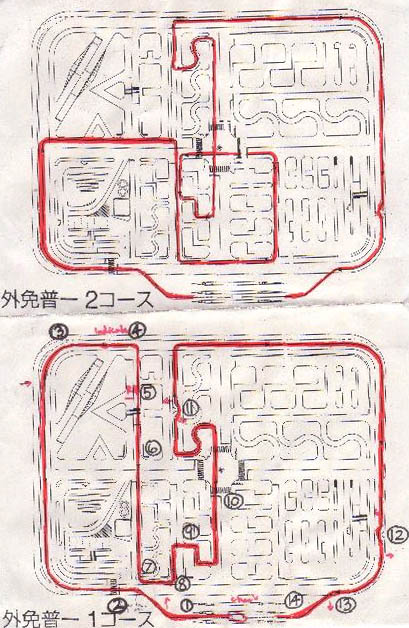
The red line indicates the course, and the numbers indicate specific tips for those specific waypoints. I took course 1, and so that is the one which I will be providing tips for. The course starts from the docking station on the bottom and runs clockwise, ending at the same birth in the docking station.
Advice Specific To Course Number One
1. Before you get in your car walk around it and inspect your vehicle. Look under the car (ostensibly to check if there is a young child or some other hazard lurking underneath). Also, it doesn’t hurt to look both ways checkihg for traffic before stepping into the street and opening your door.Once inside your car do the following even if you don’t need to:
A. Buckle your seatbelt.
B. Adjust your seat position
C. Adjust your mirrors.
D. Ask the proctor if you can turn on the ignition
E. Make sure the car is in Park and fire it up.
F. Make sure that there are no distractions (like the air conditioner on high, etc.) and that none of the malfunction lights are on.
G. Put the car into gear, take off the parking break, and signal your departure.
2. Immediately get into the lane, remembering to stay close to the left hand side. Drive slowly and make a point of checking your mirrors and blindspots and look for any pedestrians that may be about to cross (it feels silly looking out for imaginary people, but this is better than having to come spend another full day so you can do it again).
3. Once you round this corner you will be about 100 feet away from your turn. Signal right, check your mirrors and blindspots, and then pull close to the center meridian to make your turn.
4.Signal again when you get 20 feet away and check your mirrors and blindspots again, and turn. I will now assume that you know to signal, check your blindspots, and check your mirrors before you make all of your turns.
5. This is the railroad crossing. Slowly approach it, and stop at the stop line. If you are driving manual, pop the emergency break. Roll down your window to listen for the train, look both ways, check your blindspots, and then slowly proceed. Do not roll your car back down the hill or you will lose points.
6. When approaching this intersection proceed slowly. There are concrete walls on these corners obstructing your view. Come to a complete stop at the intersection, check your mirrors and blindspots, and pull forward slowly to check for traffic. When you determine it is safe, proceed forward.
7.When approaching this intersection proceed slowly. There are concrete walls on these corners obstructing your view. Come to a complete stop at the intersection, check your mirrors and blindspots, and pull forward slowly to check for traffic. When you determine it is safe,pull out slowly and turn left. Signal right away because you are approaching your next turn.
8. Do your turning checks and turn left. Immediately signal for your next right hand turn.
9. This is the part that requires finesse. This road is really small, and the right angle turns will test your driving ability. Remember to drive slowly. As you approach the right turn, stay to the left, and wait until the last moment to cut right (but not too long!). This will ensure that your back tire clears the curb. Immediately get over to the right hand side, so that you can pull the same maneuver for the left turn. After the left turn, stay to the right again, and slowly approach the intersection. Do you turn checks, and drive out close to the center meridian before turning to avoid the last tricky corner.
10. This is an intersection with a traffic signal. Drive slowly and check your mirrors, blindspots, and look for any pedestrians. If the light turns yellow before you reach the crosswalk, you should probably stop, or hit the gas so that you make it through! If you choose to do the latter, let me know how it turns out.
11. The small curvy street is cake compared to #9. Once you turn right at the intersection there is a broken down car on the left side of the road. Check your mirrors and blindspots, signal right, drive around the car and immediately signal left as you check your mirror and blindspot (to the left) and cut over once it’s safe. Do this slowly.
12. Here is a construction site. Treat it the same way as the broken down car in #11.
13. Turn into the causeway quickly, and remember to signal, etc. Head back for the same port from which you started.
14. Park within a foot of the left hand curb, put the car in park, engage the parking break, and shut down the ignition. And now its time for some more waiting!
After the test the proctor will tell you what you did wrong. In my case, I didn’t drive to the left hand side of the lane enough, and he scolded me for being “abunai” (dangerous). After I showed the appropriate amount of (less than genuine) remorse, he told me that I passed. If you fail, you can go home after you schedule your next appointment. If you pass there will be an hour or two more until you are done.
The next step is taking a photo, forking over some more cash to make the license (I think I paid about 4-5,000 yen in all). For the amount of effort that you put into obtaining a liscense, it is really dissapointing. It’s a piece of posterboard laminated on one side, and doesn’t even have any holograms! But at least it brings peace of mind, knowing that you don’t have to depend solely on being a foreigner to bail you out should you find yourself in a driving related incident involving the cops.
A little advice for those of you who are late getting your liscense converted
If you do not have a valid license (meaning that your International Drivers License has expired, or you don’t have one), DO NOT drive to the driving center. If you fail, which you may, they might watch to see how you leave. Have someone drop you off, walk, take the bus, or do something else to get there and back. If not, you risk embarrasing yourself, your employer, and you might even get into serious trouble with the police.
Props
When I was researching how to pass the test, I came upon a very useful site that provided good tips on how to pass the driving test in Japan at globalcompassion.com. It was very helpful to me, and as a form of payback I decided to write an entry similar to theirs, but tailored to Kumamoto. Their site is worth a look to supplement the information on this entry.
Many people contributed to this puddle of knowledge, and so I thank those of you who helped me out with this (Matt, Shige, Tsubasa, Mark, etc…). If this information helps you to pass the test, leave a message and let me know- I’d like to know about it. BTW, if you can think of anything that I have left out, let me know and I will add it to this entry. Good luck.
One last thing…
This entry deals with converting a foreign drivers license to a Japanese license only. If you don’t have a foreign drivers license, then I’m sorry to inform you that your test is likely harder and more expensive. In this case, your best bet is to talk to Mrs. Matsumoto.
Comment Q and A:
hey Adam
just a visitor, passing by, but wanted to say thanks for the april 13 2004 post on driving test tips in kumamoto japan.
i do have one small question, in regard to that post… so do you signal twice? i don’t get it. you say “signal 100 feet before you need to turn and again 20 feet before you turn”… so what youre saying is… signal – for a second – 100 feet before you need to turn – then turn it off – and again 20 feet before you turn?
very interesting, its new to me, the whole signalling twice thing, if in fact thats what youre suggesting.
two more questions came to mind. in the kumamoto driving test, was parallel parking required? ive never entirely mastered that. and about the course, so they give you the map before the test, but its not expected to be memorized is it? im just a bit concerned about how much of the proctor’s commands ill understand… could you post a brief list of useful proctor-driving-commands to listen for.
thanks.
james
James,
I’m glad you found that post useful. As for your questions:
1. Yes, you signal 2 times, once 100 feet before you turn and during your turn (check how I wrote it again, because I don’t remember the test so well right now). It’s something that you won’t do in real life, but they insist on you doing on the course.
2. Parallel parking- there was none when I took it. The closest thing to parallel parking was pulling the car up along the parking station where you start and finish the course. Take it slow, and it’s a piece of cake.
3. It is best to remember the course, which is easy if you look at the map and walk through it a few times with map in hand. As for commands, they’re pretty easy and go something like:
Ikimasu- go
yukkuri- slow
Migi o magatte- turn right
Hidari o magatte- turn left
Koko ni tomete- stop here
That’s about the extent of what I remember. Another piece of advice- take along a dictionary and something to write with and on just in case.
10 Kaigi Haiku
Last week I was insanely busy so I had no time to post anything, and now that I am free my internet connection at home is temporarily offline. As soon as I get my problems sorted out, I will resume posting regularly.
Today we had a long meeting with members from Hokubu Shogakko, Yamaga Shogakko, and Ubuyama Chugakko in attendance. This year, the 6th graders will be attending interschool lessons once a week for the whole day in the chugakko, as a new test program. Eventually, the plan is to unite all three schools in a new 1st though 8th grade facility, but the village is still deciding whether or not it is an economic viability.
The new program sounds like a progressive, daring idea on one hand (especially for classes other than English, which will have one or two teachers leading the class), and a waste of resources on the other. I will now be teaching about 30 kids with the help of 4 other teachers. Will having 5 teachers in an English class, with a 1 teacher/6 student ratio, help the students to develop an interest in English and foreign subject matter? Since only 2 of us use English in the classroom while the rest usually prefer to remain in a trance for the duration, I will try and spread around the responsibility of teaching and providing input and feedback to get everyone involved instead of contemplating Koan in their hiding places in the back of the room.
The meeting lasted 2 hours and I zoned out for most of it. The only thing that saved me was creating lesson plans, scratching out kanji, and practicing haiku. Needless to say, I created 2 good lesson plans to start off with and 10 haiku. Maybe the haiku will help to sketch the meeting as I experienced it.
An open forum
Only two people talking
Of fifteen of us
Last year’s lesson plan
Drafted by a green teacher
Needs to be revised
Five teachers, one class
is this a good idea?
something tells me no
Asses getting sore
The creak of old folding chairs
Objection sustained!
Kocho looks at me
Our Ill Communication
The others stare down
Meiso, ima
tsumaranai meetingu
geijitsu tohii
Japanese mind fog
My brain is simmering down
And nothing is left
Mind crushing boredom
Caffeine not working for me
Must get out of here
“Blah blah ALT”
Spine unconsciously straightens
Relax, false alarm
Fallen sakura
Students fighting with blossoms
Seen though a window
It must have looked like I was paying attention and taking notes like everyone else. I was being productive, just not in the manner of anyone else in the room. If only they let me bring my computer to meetings I could play Mafia while they were talking about time allocation between subjects.
Japanese Fire Drill
Today I woke up at 7:00, donned my blue firefighter uniform, stepped into my shiny black rainboots, and drilled until noon with all of the men of the Ubuyama Fire Brigade. As the token foreigner in the force, it is usually my job to hold my regiment’s flag, and present it whenever the command “kiritsu!” is ordered, and retract it when “naode!” is yelled out, meaning that I push and pull the flag up and down quite a few times on these mornings. Today, they let me try simple drills with everyone else, as well as being flag monkey.
The orders are actually quite simple, as are the movements, however they are hard to learn at the same time when order after order is bellowed in quick succession. I observed and mimicked the others, but this was my first time doing these drills. After many mistakes, and asking the instructing officers from the elite Aso/Kuju Fire Department how to correctly perform the drills, it all came together pretty well. I felt humiliated for not knowing the slightest thing about marching drills, but not embarrassed.
Surprisingly, I was not the only one screwing up. You can probably blame it on a nice Saturday morning, and the fact that everyone was forced to give it up to drill over and over again, and many people were obviously hungover. The second in command could not figure out how to run and stop properly when moving from our regimental formation to the inspecting team, and so he was laughed at and drilled many more times than I was. Also, it was interesting to see that the Fire Department does not tolerate the use of strong Higoben (the oldschool Kumamoto accent). The regimental sub-leader summoned a strong “Iiyussha!” and was reprimanded several times after this for continuing to use this corruption of the word “Yosh(i)”, meaning “A-OK”.
What perplexes me about “Fire Brigade Practice” is that at no point is there any fire or fire drills. This time I didn’t even get to watch the other firemen shoot the waterhose because today was devoted to marching and formation drills. I’m not sure what the average resident of Ubuyama feels, but personally I want the firefighters in my area to be trained professionals and wise old hands. That is, I want them to be specifically trained to deal with real life situations involving fire-based problems, and for performing other rescue operations such as but not limited to the use of the fire hose and water pump (remember, fire hydrants and cisterns are not cost effective or particularly useful in the deep country), various fire extinguishers, shovels, picks, rescue axes, fire (in case they need to make a fire line), fire retardants, ladders, ropes, climbing equipment, use of special suits and masks, educating the general public about fire avoidance and mitigation techniques, first aid and CPR, and being able to save cute little fluffy kittens and puppy dogs caught in all sorts of perilous situations. I don’t particularly care if they march to the scene in a tight, professional formation in cadence, or if they can snap off a crisp salute. In fact, when that alarm bell rings, I want those guys to drop their instant ramen, quickly and carefully don their equipment, and haul ass over to the problem. I don’t want them marching at double time, I want them to drive at three times the speed limit, obliterating any inanimate objects that dare to be in the path of the fire engine!
However, I am not complaining about the Fire Brigade. I am merely baffled and find myself asking many questions. Why don’t they devote at least as much time to practice putting out fires as they do marching? Why do they want me on the squad just to hold the flag? Why do they want to award me with a Fire Cheif commemorative patch when I leave Ubuyama? Why are they going to take me to Okinawa for the second time in one year later this month? No, I am not complaining.
Wait, what? The Fire Brigade is paying for me to go to Okinawa again? That’s right! On the last trip after hearing that diving was one of my hobbies, everyone decided to try it and they all immensely enjoyed themselves. And so this time, we’re diving off of a boat close to one of Okinawa’s smaller islands!
So what does a token gaijin learn when he is in the service of the Fire Brigade in the cho inaka? He learns how to march, he learns how to present the flag, but most of all, he learns about the best omiyage to buy from the other firemen on his trips to Okinawa.
April Foolishness
Ah, UCSB: We partied at Del Playa, Sabado Tarde, Picasso, Anacapa, State Street, and too many other places to name. Long Island Iced Tea night, 5 gallons of hurricaine punch, a hundred jello shots, a fully stocked bar, runs to Trader Joes for cheap booze, riding Bills Bus and drinking from the Trolley on the way downtown, the 5 keg birthday bashes with the Sierra Nevada and Rolling Rock keg hidden in the back room. These were the telltale signs of epic nights and countless birthdays, of finishing your finals, of graduating, of any given weekend, or of a week where no one had any tests. Barbecues next to the beach in the rain, mud football (I wonder if we played with Jack Johnson, es posible, no?), and watching TV off of the scratched 5 inch screen and my VCR with no rewind. This was the time where quarters were more valuable than any other form of currency, when everything was shut down for the night in the dorms, when we bought 2 Wildbreads from Woodstocks instead of 1 large pizza to make those meager dollars and coins from under the couch cushions stretch. Ramen saved our asses on several occasions, and we learned to make chowmein and other variations on this versatile staple by frying the noodles. We staved off scurvy with lemon drops and lime and tequila shots. Adaptability was a way of life rather than an occasionally useful personality trait. Ah, “back in the day when I was young I’m not a kid anymore…”.
Which brings me to the focus of this post: Having fun at the expense of our friends. There are many reasons why it is not a good idea to have any group of young men living together in close proximity for too long. The sink piles up with undone dishes providing a better growth medium for fungus and bacteria than an auger/blood medium, the trash becomes a giant game of Jenga, and the endless battle against Entropy is only fought when parents or prospective dates are brought home. Even the neat members of the group succumb to living as slobs, because it is just not fair that they should pick up after the other pigs in the house! The pigs are more than happy to let the pad degrade into a biohazardous dump because they resent being called pigs, are generally lazy, and find a sort of joy in watching the neat freaks suffer while trying to fight their Vietnam.
Eventually there comes a breaking point. Sometimes harsh words are exchanged and people storm out. Impromptu wrestling matches break out on the deeply stained, chunk-style (chunks being chips, pizza toppings, toe nails, and other various detritus), carpet that reeks of gallons of Red Dog beer. Conspiracies are formed and alliances shift around like dominos being washed (Domino Muthafucka!). And agression slowly builds, ever mounting higher and higher. Reasons? We don’t need no stinkin’ reasons! And so begins the cycle of vendetta.
The best plans are either the epic ones that take a lot of planning, or the flashes of inspiration that only hours of Warcraft/Starcraft/Counterstrike/Pirated Cable TV can bring. Enter my part-time job. One Christmas, I worked with my sister and her boyfriend doing a job with no general fitting description other than “miscellaneous”. One of the charges of the job was packing gift baskets, and sending them off to people like Jerry Falwell and other people with horrifyingly bad taste in Chrismas presents. They buy this crap for aquaintances and people that you don’t necessarily like but still have to give a token of recognition due to social pressures with money culled from the collection plates. Do they even try to justify their sacreligious spending of the Lord’s money on frivolous baskets of decorated candy, or do they laugh frequently and heartily at all of the suckers? Anyhow, at the end of the season, we had two huge bags of styrafoam peanuts left over. I didn’t know what I was going to do with these environmentally unfriendly curls of white death, but I knew that I needed them for something.
And then the perfect opportunity came: Chris’ 21st birthday. Me and Brian painstakingly developed a plan to make sure that everything was in place. The door was locked during the party to keep out the roaming stranger kleptos and so I told Steve, who shared the room with Chris, that I needed something out of his room. Leaving him to tend the keg (the kleptos love to steal keg taps! we give them free beer, and they steal the hardware that allows everyone to get the beer out of the keg? go figure!) sneaked into their room with the foam and dumped it on the ground, covering up scattered cairns of textbooks, soiled laundry, nuggets of mystery, and computer parts. Next, we set up the box fan, creating a feathery blizzard. It was Art in motion, truly satisfying work.
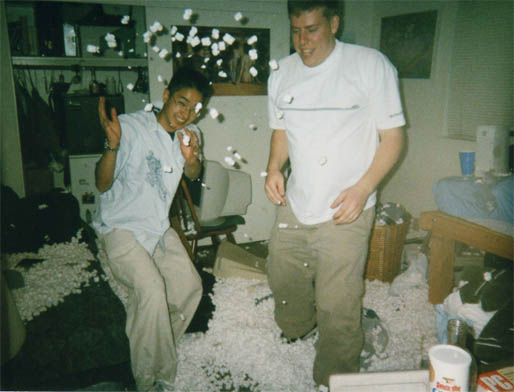
Rebecca took pictures of our triumph, and we turned off the lights, locked the door, and got back to the festivities. Steve walked into his room and discovered the chaos soon afterwards. He was really pissed off but he also found humor in the situation, punching us with a big smile on his face. Chris, who arrived right after Steve, did not share the same sentiments. He was in a bad mood, and we didn’t understand why. This was obviously some well deserved birthday hazing, and all in good fun, so we were relentless in making fun of him. This just added to his anger, instead of grudging laughter as we had expected.
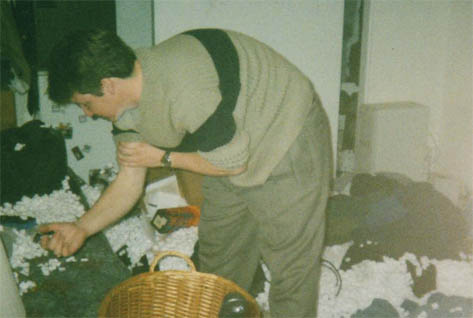
No smile on this face. The girls were the first ones to spot that something was wrong, and the rest of us went on partying. However, we were forced by the girls to appologize and it was not accepted. This sucked: we just wanted to shock and annoy Chris and Steve, not to drive Chris into a rage on the night of his birthday. There was nothing to do but to give the man his space. We couldn’t get into our rooms because Steve had locked our door which didn’t have a key (payback of roughly the same magnitude as our joke), but this would not be a problem. We saw Chris come into the kitchen, grab the 5 gallon bottle of water, and then heard a resounding “BOOM!” as the hollow framed door buckled. The bastard had kicked down our door like Cochese, and was pouring water all over our matresses. He tossed the spent bottle to the floor, saying “O.K., now I forgive you.”. Now although this was the equivalent of getting back at at someone by punching them in the face for talking smack, there was nothing to do but laugh in this situation. It was funny after all, it really was.
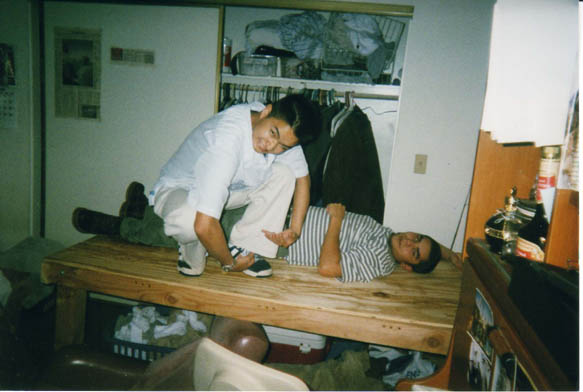
That night, I slept on the soggy slab of plywood that had held my bed off the floor. I slept pretty well, but woke up sore with a hangover, still laughing from the previous night’s events.
For the remainder of our time in college, Chris remained bitter about the incident. It was “not funny”. I think that he had always secretly thought that the incident was funny, but just didn’t want to admit it out of pride. Then again, maybe not.
All of shit that we gave one another was given out of the desire to humiliate and to entertain, but also to share our own brand of love. Only good friends can be so cruel to eachother, and still be good friends after so long. These are among my fondest memories of college.

